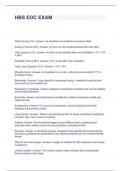Reserve volume rv - Study guides, Class notes & Summaries
Looking for the best study guides, study notes and summaries about Reserve volume rv? On this page you'll find 233 study documents about Reserve volume rv.
Page 3 out of 233 results
Sort by
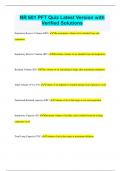
-
NR 601 PFT Quiz Latest Version with Verified Solutions
- Exam (elaborations) • 4 pages • 2024
- Available in package deal
-
- $8.99
- + learn more
NR 601 PFT Quiz Latest Version with Verified Solutions Expiratory Reserve Volume (ERV) The maximum volume of air exhaled from end expiration. Inspiratory Reserve Volume (IRV) Maximum volume of air inhaled from end inspiration Residual Volume (RV) The volume of air remaining in lungs after maximum exhalation. Tidal Volume (VT or TV) Volume of air inhaled or exhaled during each respiratory cycle Functional Residual capacity (FRC) Volume of air in the lungs at rest end expiration Inspiratory C...
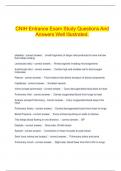
-
CNIH Entrance Exam Study Questions And Answers Well Illustrated.
- Exam (elaborations) • 11 pages • 2024
-
- $10.99
- + learn more
CNIH Entrance Exam Study Questions And Answers Well Illustrated. platelets - correct answer. small fragments of larger cells produced in bone marrow that initiate clotting Leukocyte (wbc) - correct answer. Protect against invading microorganisms Erythrocyte (rbc) - correct answer. Contain hgb and enables cell to bind oxygen molecules Plasma - correct answer. Fluid medium that allows transport of blood components Capillaries - correct answer. Smallest vesse...
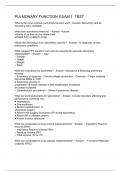
-
PULMONARY FUNCTION EXAM 1 TEST
- Exam (elaborations) • 5 pages • 2023
-
- $10.99
- + learn more
What is the most common pulmonary function test? - Answer- Spirometry and its becoming more available what does spirometry measure? - Answer- Volume Velocity of air that can be inhaled and exhaled from a patient's lungs. Whats the information from spirometry used for? - Answer- To diagnose various pulmonary conditions. What causes PFT results to vary and are required for accurate spirometry interpretation? - Answer- ○ Age ○ Gender ○ Height ○ Weight ○ Race Waht are in...
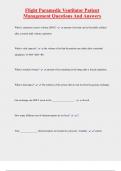
-
Flight Paramedic Ventilator Patient Management Questions And Answers
- Exam (elaborations) • 9 pages • 2024
- Available in package deal
-
- $13.49
- + learn more
Flight Paramedic Ventilator Patient Management Questions And Answers What is expiratory reserve volume (ERV)? amount of air that can be forcefully exhaled after a normal tidal volume expiration What is vital capacity? the volume of air that the patient can exhale after a maximal inhalation. Vt+IRV+ERV+RV What is residual volume? amount of air remaining in the lungs after a forced expiration. What is dead space? The surfaces of the airway that are not involved in gaseous exchange. Gas ...
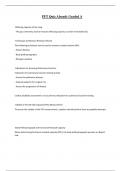
-
PFT Quiz Already Graded A
- Exam (elaborations) • 6 pages • 2024
-
Available in package deal
-
- $10.29
- + learn more
PFT Quiz Already Graded A Diffusing Capacity of the Lung - The gas commonly used to measure diffusing capacity is carbon monoxide (CO). Techniques to Measure Residual Volume The following techniques can be used to measure residual volume (RV): - Helium dilution - Body plethysmography - Nitrogen washout Indications for Assessing Pulmonary Function Indications for pulmonary function testing include: - Screen for pulmonary disease - Evaluate patients for surgical risk - Assess the progres...
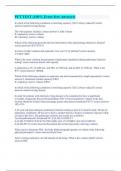
-
PFT TEST (100% Error-free Answers)
- Exam (elaborations) • 10 pages • 2023
-
Available in package deal
-
- $10.59
- + learn more
In which of the following conditions is total lung capacity (TLC) always reduced? correct answers restrictive lung disease The vital capacity includes: correct answers I. tidal volume II. inspiratory reserve volume III. expiratory reserve volume Which of the following provides the best information when determining obstructive disease? correct answers FEV1/FVC% In terms of other volumes and capacities, how can VC be defined? correct answers VT+IRV+ERV What is the most common measure...

-
NPTE FF|QUESTIONS WITH 100% CORRECT ANSWERS|VERIFIED
- Exam (elaborations) • 61 pages • 2024
-
- $20.49
- + learn more
NPTE FF Stage 1 Adhesive Capsulitis Signs and Symptoms ANSWER- - Pain Distal to Elbow and pain to palpation at Sulcus - Limited range in ER and ABD - Lasts 3 months Stage 2 Freezing Stage: Signs and Symptoms ANSWER- - Pain even at rest - Limited ROM - 9-15 months after onset Stage 3 "Frozen": Signs and Symptoms ANSWER- - Limited GH motions - Pain w/ movement - Atrophy of deltoid, biceps, rotator cuff and triceps Stage 4 "Thawing": Signs and Symptoms ANSWER- - Significant c...
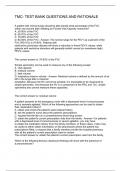
-
TMC- Test bank questions and rationale
- Exam (elaborations) • 12 pages • 2023
-
- $12.49
- + learn more
A patient with normal lungs should be able exhale what percentage of the FVC within one second after initiating an Forced Vital Capacity maneuver? A. 35-50% of the FVC B. 50-70% of the FVC C. 70-83% of the FVC D. 84-93% of the FVC - Answer- The normal range for the FEV1 as a percent of the FVC (FEV1%) is 70-83%. Patients with obstructive pulmonary disease will show a reduction in timed FEV% values, while patients with restrictive disorders will generally exhibit normal (or sometimes high)...
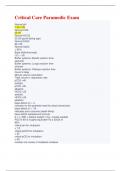
-
Critical Care Paramedic Exam 2023
- Exam (elaborations) • 31 pages • 2023
- Available in package deal
-
- $12.49
- + learn more
Normal pH - Answer- 7.35-7.45 Normal CO2 - Answer- 35-45 Normal HCO3 - Answer- 22-26 (good dating age) Normal PaO2 - Answer- 80-100 Normal SaO2 - Answer- > 95% Base (deficit/excess) - Answer- (-2) - (+2) Buffer systems: Bicarb reaction time - Answer- seconds Buffer systems: Lungs reaction time - Answer- minutes Buffer systems: Kidneys reaction time - Answer- hours to days Minute volume calculation - Answer- Tidal volume x respiratory rate pCO2 >45 - Answer- acidotic pCO2 <35 - Answer- a...

Did you know that on average a seller on Stuvia earns $82 per month selling study resources? Hmm, hint, hint. Discover all about earning on Stuvia



